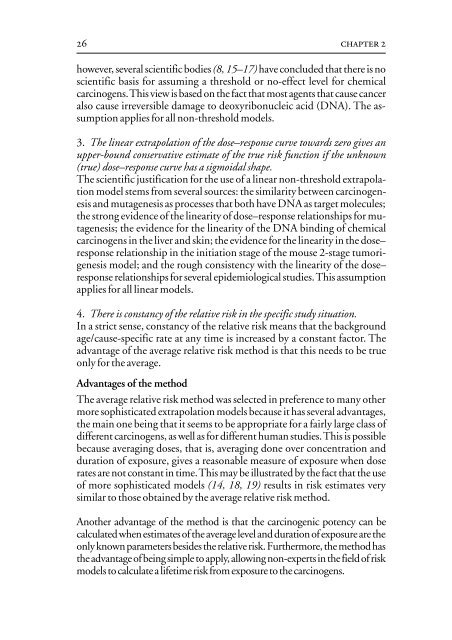Air Quality Guidelines - World Health Organization Regional Office ...
Air Quality Guidelines - World Health Organization Regional Office ...
Air Quality Guidelines - World Health Organization Regional Office ...
You also want an ePaper? Increase the reach of your titles
YUMPU automatically turns print PDFs into web optimized ePapers that Google loves.
26 chapter 2<br />
however, several scientific bodies (8, 15–17) have concluded that there is no<br />
scientific basis for assuming a threshold or no-effect level for chemical<br />
carcinogens. This view is based on the fact that most agents that cause cancer<br />
also cause irreversible damage to deoxyribonucleic acid (DNA). The assumption<br />
applies for all non-threshold models.<br />
3. The linear extrapolation of the dose–response curve towards zero gives an<br />
upper-bound conservative estimate of the true risk function if the unknown<br />
(true) dose–response curve has a sigmoidal shape.<br />
The scientific justification for the use of a linear non-threshold extrapolation<br />
model stems from several sources: the similarity between carcinogenesis<br />
and mutagenesis as processes that both have DNA as target molecules;<br />
the strong evidence of the linearity of dose–response relationships for mutagenesis;<br />
the evidence for the linearity of the DNA binding of chemical<br />
carcinogens in the liver and skin; the evidence for the linearity in the dose–<br />
response relationship in the initiation stage of the mouse 2-stage tumorigenesis<br />
model; and the rough consistency with the linearity of the dose–<br />
response relationships for several epidemiological studies. This assumption<br />
applies for all linear models.<br />
4. There is constancy of the relative risk in the specific study situation.<br />
In a strict sense, constancy of the relative risk means that the background<br />
age/cause-specific rate at any time is increased by a constant factor. The<br />
advantage of the average relative risk method is that this needs to be true<br />
only for the average.<br />
Advantages of the method<br />
The average relative risk method was selected in preference to many other<br />
more sophisticated extrapolation models because it has several advantages,<br />
the main one being that it seems to be appropriate for a fairly large class of<br />
different carcinogens, as well as for different human studies. This is possible<br />
because averaging doses, that is, averaging done over concentration and<br />
duration of exposure, gives a reasonable measure of exposure when dose<br />
rates are not constant in time. This may be illustrated by the fact that the use<br />
of more sophisticated models (14, 18, 19) results in risk estimates very<br />
similar to those obtained by the average relative risk method.<br />
Another advantage of the method is that the carcinogenic potency can be<br />
calculated when estimates of the average level and duration of exposure are the<br />
only known parameters besides the relative risk. Furthermore, the method has<br />
the advantage of being simple to apply, allowing non-experts inthe field of risk<br />
models to calculate a lifetime risk from exposure to the carcinogens.

















